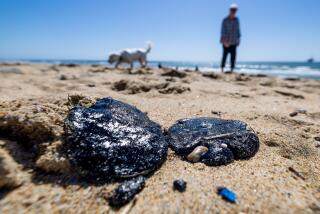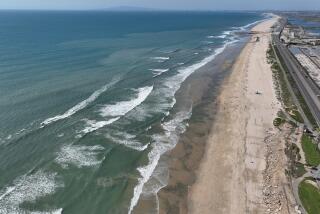Galveston Oil Spill Washes Ashore : Environment: Wildlife official says marshlands could be devastated, but the Coast Guard calls the situation ‘manageable.’
- Share via
GALVESTON, Tex. — Oil from a huge spill in Galveston Bay began washing ashore Tuesday, threatening an environmentally sensitive shoreline that is the nesting place for thousands of birds and also one of the prime fisheries along the Texas coast.
More than 500,000 gallons of oil have escaped into the bay since a tanker-barge collision Saturday, and one state parks and wildlife official said the danger was such that the marshlands could be devastated.
“It’s heading toward worst case,” said Larry McKinney, the director of the resource protection division of the Texas Parks and Wildlife Division. “What is happening is as bad as we could ever predict.”
However, others took exception to that gloomy outlook, including U.S. Coast Guard Rear Adm. James Loy, who flew over the bay Tuesday afternoon.
Loy said the spill looked like a “very manageable situation.”
“I think we have a pretty good handle on the environmentally sensitive areas,” he said at a midafternoon press conference. “My aerial observation did not give me that same sense of foreboding.”
Cleanup crews were using five skimmer vessels and a vacuum truck to suck up oil contained by thousands of feet of booms.
The oil spill is the second within the last two months to affect the Galveston Bay area. The first was an explosion aboard the tanker Mega Borg on June 9. The tanker burned out of control for days and almost 4 million gallons of oil were spilled into the Gulf of Mexico. For a time, it appeared the Mega Borg might eclipse the Valdez disaster because it carried three times more oil than the Exxon tanker that ran aground off the coast of Alaska.
The accident Saturday occurred when two of three barges being pushed by a tug boat collided with a tanker in the Houston Ship Channel, a deep trench that cuts through Galveston Bay. First indications were that it was a relatively minor spill. But late Monday afternoon, the Coast Guard revised its estimate to 500,000 gallons after divers discovered that damage to one of the barges was much more severe that originally believed. No oil has spilled since Monday evening, the Coast Guard said.
What worried environmental experts about the bay spill was that it was already so close to the shoreline. At midafternoon, the sheen from the spill was more than eight miles long and four to five miles wide.
Adm. Loy said Coast Guard Capt. Tom Greene, the federal on-site coordinator, said the oil had washed ashore in some portions of the bay and that there had been some reports of birds that were covered with oil.
At least 100 bird species, including the endangered brown pelican, and at least 75 kinds of fish inhabit the Galveston Bay area.
Meanwhile, a spokesman for state Lands Commissioner Garry Mauro said that Texas must improve its response time to these potentially disastrous spills. Mauro has been urging such preparations since the Exxon Valdez disaster.
“Garry has been hollering about a preparedness plan all this time, but it’s not there,” said spokesman Jeff Long. “No one has ever put it together. The response has been slow and we’re real unhappy.”
David Hankla, the Houston-area field supervisor for the U.S. Fish and Wildlife Department, said one of the problems is the proximity of wildlife to the heavy industry of the Houston Ship Channel.
“We’re trying to make all of it mix and match together, to maintain a productive system for the long term, but it’s not easy,” he said. “On this spill, we’re just holding our breath.”
At his press conference, Loy also announced that the ship channel was to reopen Tuesday afternoon. The channel’s closure was costing shippers about $1.5 million a day.
More to Read
Sign up for Essential California
The most important California stories and recommendations in your inbox every morning.
You may occasionally receive promotional content from the Los Angeles Times.










